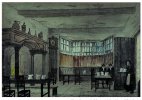Two views of the inn at different times. There are a lot of features that match up, but the building must have been changed after the first building. Both paintings are clearly labelled as the Waggon and Horses, Handsworth. The first is a watercolour by John Lawrence Hart in 1877, the second is by W. Green (only 19th century given as a date). I’m guessing that the second one is the later, improved building, as the frontage has changed. Viv.




Last edited:







